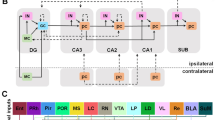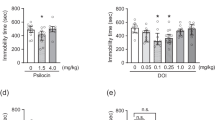Abstract
Rationale
We previously demonstrated in mice that the activation of prelimbic medial prefrontal cortex (PL) with the sodium channel activator veratrine induces anxiety-like behaviors via NMDA receptor-mediated glutamatergic neurotransmission. Riluzole directly affects the glutamatergic system and has recently been suggested to have an anxiolytic-like effect in both experimental animals and patients with anxiety disorders.
Objectives
We investigated the effects of co-perfusion of riluzole on veratrine-induced anxiety-like behaviors in mice.
Methods
Extracellular glutamate levels were measured in 7-week-old male C57BL6 mice by using an in vivo microdialysis–HPLC/ECD system, and behaviors were assessed simultaneously in an open field (OF) test. Basal levels of glutamate were measured by collecting samples every 10 min for 60 min. The medium containing drugs was perfused for 30 min, and the OF test was performed during the last 10 min of drug perfusion. After the drug treatments, the drug-containing medium was switched to perfusion of control medium lacking drugs, and then samples were collected for another 90 min.
Results
Riluzole co-perfusion attenuated veratrine-induced increase in extracellular glutamate levels in the PL and completely diminished veratrine-induced anxiety-like behaviors. Interestingly, riluzole perfusion alone in the PL did not affect the basal levels of glutamate and anxiety-like behaviors.
Conclusions
Our results suggest that compounds like riluzole that inhibit glutamatergic function in the PL are possible candidates for novel anxiolytics.




Similar content being viewed by others
References
Abarca C, Silva E, Sepúlveda MJ, Oliva P, Contreras E (2000) Neurochemical changes after morphine, dizocilpine or riluzole in the ventral posterolateral thalamic nuclei of rats with hyperalgesia. Eur J Pharmacol 403:67–74
Azbill RD, Mu X, Springer JE (2000) Riluzole increases high-affinity glutamate uptake in rat spinal cord synaptosomes. Brain Res 871:175–180
Benoit E, Escande D (1991) Riluzole specifically blocks inactivated Na channels in myelinated nerve fibre. Pflugers Arch 419:603–609
Corcoran KA, Quirk GJ (2007) Activity in prelimbic cortex is necessary for the expression of learned, but not innate, fears. J Neurosci 27:840–844
Coric V, Milanovic S, Wasylink S, Patel P, Malison R, Krystal JH (2003) Beneficial effects of the antiglutamatergic agent riluzole in a patient diagnosed with obsessive–compulsive disorder and major depressive disorder. Psychopharmacol (Berl) 167:219–220
Coric V, Taskiran S, Pittenger C, Wasylink S, Mathalon DH, Valentine G, Saksa J, Wu YT, Gueorguieva R, Sanacora G, Malison RT, Krystal JH (2005) Riluzole augmentation in treatment-resistant obsessive–compulsive disorder: an open-label trial. Biol Psychiatry 58:424–428
Duprat F, Lesage F, Patel AJ, Fink M, Romey G, Lazdunski M (2000) The neuroprotective agent riluzole activates the two P domain K(+) channels TREK-1 and TRAAK. Mol Pharmacol 57:906–912
Enginar N, Hatipoğlu I, Firtina M (2008) Evaluation of the acute effects of amitriptyline and fluoxetine on anxiety using grooming analysis algorithm in rats. Pharmacol Biochem Behav 89:450–455
Franklin K, Paxinos G (2008) The mouse brain in stereotaxic coordinates, 3rd edition. Elsevier
Frizzo ME, Dall'Onder LP, Dalcin KB, Souza DO (2004) Riluzole enhances glutamate uptake in rat astrocyte cultures. Cell Mol Neurobiol 24:123–128
Fumagalli E, Funicello M, Rauen T, Gobbi M, Mennini T (2008) Riluzole enhances the activity of glutamate transporters GLAST, GLT1 and EAAC1. Eur J Pharmacol 578:171–176
Grant P, Lougee L, Hirschtritt M, Swedo SE (2007) An open-label trial of riluzole, a glutamate antagonist, in children with treatment-resistant obsessive–compulsive disorder. J Child Adolesc Psychopharmacol 17:761–767
Hoover WB, Vertes RP (2007) Anatomical analysis of afferent projections to the medial prefrontal cortex in the rat. Brain Struct Funct 212:149–179
Irifune M, Kikuchi N, Saida T, Takarada T, Shimizu Y, Endo C, Morita K, Dohi T, Sato T, Kawahara M (2007) Riluzole, a glutamate release inhibitor, induces loss of righting reflex, antinociception, and immobility in response to noxious stimulation in mice. Anesth Analg 104:1415–1421, table of contents
Jehle T, Bauer J, Blauth E, Hummel A, Darstein M, Freiman TM, Feuerstein TJ (2000) Effects of riluzole on electrically evoked neurotransmitter release. Br J Pharmacol 130:1227–1234
Kelly JP, Wrynn AS, Leonard BE (1997) The olfactory bulbectomized rat as a model of depression: an update. Pharmacol Ther 74:299–316
Mathew SJ, Amiel JM, Coplan JD, Fitterling HA, Sackeim HA, Gorman JM (2005) Open-label trial of riluzole in generalized anxiety disorder. Am J Psychiatry 162:2379–2381
Mcdonald AJ, Mascagni F, Guo L (1996) Projections of the medial and lateral prefrontal cortices to the amygdala: a phaseolus vulgaris leucoagglutinin study in the rat. Neuroscience 71:55–75
Muigg P, Scheiber S, Salchner P, Bunck M, Landgraf R, Singewald N (2009) Differential stress-induced neuronal activation patterns in mouse lines selectively bred for high, normal or low anxiety. PLoS One 4:e5346
Myers-Schulz B, Koenigs M (2012) Functional anatomy of ventromedial prefrontal cortex: implications for mood and anxiety disorders. Mol Psychiatry 17:132–141
Peña F, Tapia R (2000) Seizures and neurodegeneration induced by 4-aminopyridine in rat hippocampus in vivo: role of glutamate- and GABA-mediated neurotransmission and of ion channels. Neuroscience 101:547–561
Perrot-Sinal TS, Gregus A, Boudreau D, Kalynchuk LE (2004) Sex and repeated restraint stress interact to affect cat odor-induced defensive behavior in adult rats. Brain Res 1027:161–172
Pittenger C, Coric V, Banasr M, Bloch M, Krystal JH, Sanacora G (2008) Riluzole in the treatment of mood and anxiety disorders. CNS Drugs 22:761–786
Prakriya M, Mennerick S (2000) Selective depression of low-release probability excitatory synapses by sodium channel blockers. Neuron 26:671–682
Saitoh A, Ohashi M, Suzuki S, Tsukagoshi M, Sugiyama A, Yamada M, Oka JI, Inagaki M (2014) Activation of the prelimbic medial prefrontal cortex induces anxiety-like behaviors via N-methyl-d-aspartate receptor-mediated glutamatergic neurotransmission in mice. J Neurosci Res
Sanacora G, Kendell SF, Levin Y, Simen AA, Fenton LR, Coric V, Krystal JH (2007) Preliminary evidence of riluzole efficacy in antidepressant-treated patients with residual depressive symptoms. Biol Psychiatry 61:822–825
Sanacora G, Zarate CA, Krystal JH, Manji HK (2008) Targeting the glutamatergic system to develop novel, improved therapeutics for mood disorders. Nat Rev Drug Discov 7:426–437
Sasaki-Hamada S, Sacai H, Sugiyama A, Iijima T, Saitoh A, Inagaki M, Yamada M, Oka J (2013) Riluzole does not affect hippocampal synaptic plasticity and spatial memory, which are impaired by diazepam in rats. J Pharmacol Sci 122:232–236
Song JH, Huang CS, Nagata K, Yeh JZ, Narahashi T (1997) Differential action of riluzole on tetrodotoxin-sensitive and tetrodotoxin-resistant sodium channels. J Pharmacol Exp Ther 282:707–714
Sugiyama A, Saitoh A, Iwai T, Takahashi K, Yamada M, Sasaki-Hamada S, Oka J, Inagaki M (2012) Riluzole produces distinct anxiolytic-like effects in rats without the adverse effects associated with benzodiazepines. Neuropharmacology 62:2489–2498
Takahashi K, Murasawa H, Yamaguchi K, Yamada M, Nakatani A, Yoshida M, Iwai T, Inagaki M, Saitoh A (2011) Riluzole rapidly attenuates hyperemotional responses in olfactory bulbectomized rats, an animal model of depression. Behav Brain Res 216:46–52
Takeda A, Tamano H, Kan F, Itoh H, Oku N (2007) Anxiety-like behavior of young rats after 2-week zinc deprivation. Behav Brain Res 177:1–6
Urbani A, Belluzzi O (2000) Riluzole inhibits the persistent sodium current in mammalian CNS neurons. Eur J Neurosci 12:3567–3574
Van Eden CG, Uylings HB (1985) Cytoarchitectonic development of the prefrontal cortex in the rat. J Comp Neurol 241:253–267
Vertes RP (2004) Differential projections of the infralimbic and prelimbic cortex in the rat. Synapse 51:32–58
Vidal-Gonzalez I, Vidal-Gonzalez B, Rauch SL, Quirk GJ (2006) Microstimulation reveals opposing influences of prelimbic and infralimbic cortex on the expression of conditioned fear. Learn Mem 13:728–733
Wang SJ, Wang KY, Wang WC (2004) Mechanisms underlying the riluzole inhibition of glutamate release from rat cerebral cortex nerve terminals (synaptosomes). Neuroscience 125:191–201
Zarate CA, Payne JL, Quiroz J, Sporn J, Denicoff KK, Luckenbaugh D, Charney DS, Manji HK (2004) An open-label trial of riluzole in patients with treatment-resistant major depression. Am J Psychiatry 161:171–174
Zona C, Siniscalchi A, Mercuri NB, Bernardi G (1998) Riluzole interacts with voltage-activated sodium and potassium currents in cultured rat cortical neurons. Neuroscience 85:931–938
Acknowledgments
This research was supported by research grants from Intramural Research Grant (24-2) for Neurological and Psychiatric Disorders of NCNP, Japan.
Author information
Authors and Affiliations
Corresponding author
Rights and permissions
About this article
Cite this article
Ohashi, M., Saitoh, A., Yamada, M. et al. Riluzole in the prelimbic medial prefrontal cortex attenuates veratrine-induced anxiety-like behaviors in mice. Psychopharmacology 232, 391–398 (2015). https://doi.org/10.1007/s00213-014-3676-1
Received:
Accepted:
Published:
Issue Date:
DOI: https://doi.org/10.1007/s00213-014-3676-1




